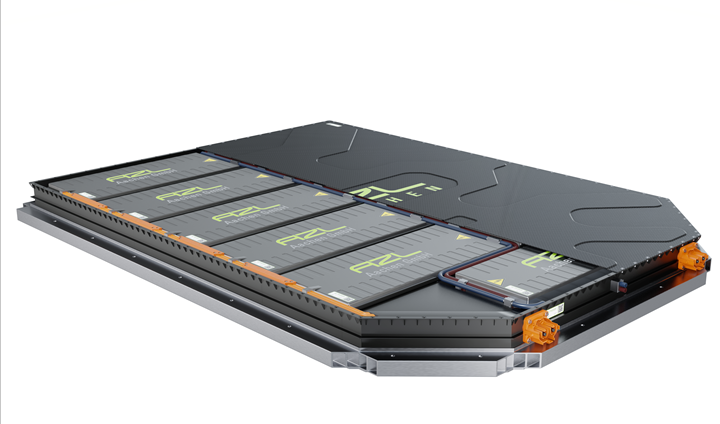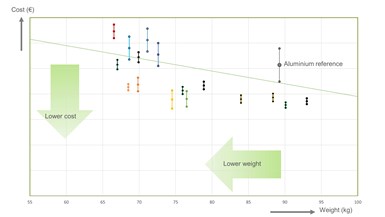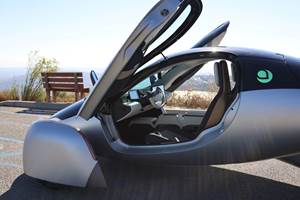AZL Aachen with 46 industry partners successfully complete multi-material battery casings project
Multi-material solutions, including consideration of composites, open up high potential for cost and weight savings for battery casings, with follow-up projects to come in 2022.

Battery casing concept. Photo Credit, all images: AZL
AZL Aachen (Germany), with a total of 46 industrial partners, have reported the successful completion of its project on multi-material battery casings, previously announced in September 2020. The AZL says several different concepts for plastic-based, multi-material battery casings were developed, with which significant weight and cost savings are possible. Throughout the project, consideration of using composites to fulfill various functions was also investigated. Additionally, in the course of the project, two important core topics emerged that are to be dealt with in separate follow-up projects beginning Jan. 26, 2022: bottom impact protection and fire resistance. Further, a project for the development and realization of prototypes is planned for the middle of the year in 2022.
Battery casings are among the key components in electric vehicles (EVs), most of which are usually made of aluminum. It was this challenge that the AZL and its consortium of car manufacturers, automotive suppliers, raw material producers and machine suppliers analyzed. “The enormous response from industry underlines the relevance of the topic,” says project leader Warden Schijve, pleased with the progress and results. According to the AZL, up to 36% weight and up to 20% costs can be saved if multi-material composites are used instead of conventional solutions
Weight and cost saving potentials for different multi-material battery casings compared to aluminum reference casing.
To obtain these results, the AZL, with the cooperation of its partner companies including Audi (Ingolstadt, Germany), Asahi Kasei (Tokyo, Japan), Covestro (Leverkusen, Germany), EconCore (Leuven, Belgium), IPTE (Genk, Belgium), Johns Manville (JM, Denver, Colo., U.S.), Teijin Ltd. (Tokyo, Japan), DSM (Heerlen, Netherlands), Faurecia (Nanterre, France), Formosa (Taipei City, Taiwan), Hengrui (China), Hutchinson (Paris, France), Magna (Aurora, Canada) and Marelli (Corbetta, Italy) first defined five sub-components of a battery casing: The enclosure tray, the bottom protection plate, the crash frame, the cross beams and the enclosure lid. In addition, the partners analyzed a total of 44 market-relevant, existing series components and concepts in more detail and compiled a comprehensive overview of the various standards and requirements at national, international and OEM level. The premise was to achieve the same or even better mechanical performance than conventional solutions. For example, at least the same stiffness, safety in case of side impact, EMI shielding and flame protection should be available. In order to determine alternative solutions, the AZL developed 20 design concepts with different material combinations. To analyze and design the different concepts, more than 500 FEM models were created and more than 1,500 CAE simulations were performed.
“Battery housings are a key component in EVs. In the joint project, the AZL comprehensively investigated the demanding requirements and developed concepts on how plastic-based multi-material solutions can save weight and costs compared to status quo solutions made of metals,” says Dr.-Ing. Florian Meyer, project management mentor on the part of Audi AG’s Technical Development. “The collaboration with the cross-value chain and cross-material class consortium enabled a creative exchange and new impulses. As Audi AG, we were able to use the project voucher included in our AZL Business+ partnership efficiently in this project initiative.”
Composite materials including thermoplastic and thermosets, sheet molding compound (SMC), pultruded profiles, fabrics, unidirectional (UD) materials, sandwich (foam, honeycomb and D-LFT core), as well as long fiber thermoplastics (LFT) and hybrid overmolding (tape + injection molding) were studied to fulfill battery casing functions.
“The project and the enormous response from industry not only show us the relevance of the topic, but also the potential of alternative multi-material composites,” Schijve says, referring to this completed project, as well as the follow-up ones to come. “In addition to individual development projects, we will start on Jan. 26, 2022 ,with two follow-up activities in the format of jointly funded Joint Partner Projects and invite new companies to participate in these projects.”
While follow-up project one deals with an application-related test method and the investigation of the safety of different material combinations for bottom impact protection, follow-up project two focuses on the fire resistance of different materials and material combinations. The aim is to develop test methods that allow impact/fire resistance to be investigated at material level, taking into account the specific requirements of a battery casing in comparison with standard materials.
Related Content
Aptera reveals first composite production parts for BinC vehicle
Pre-production efforts are underway to begin building production-intent vehicles.
Read MoreAptera expands presence of solar electric vehicle into UAE
The UAE will provide an ideal environment to introduce the company’s solar-powered composites-intensive BinC vehicle internationally.
Read MoreBcomp ampliTex makes appearance in Cupra EV Cup Bucket seats
The entire Cupra Born VZ line-up features all-natural fiber front seats that highlight functionality, aesthetics and reduced CO2 emissions.
Read MoreSABIC launches fiber-reinforced, intumescent, fire-retardant resins
SABIC PP compound H1090 and Stamax 30YH611 resins are well suited for extruding and thermoforming large, complex EV battery pack components for automotive.
Read MoreRead Next
VIDEO: High-volume processing for fiberglass components
Cannon Ergos, a company specializing in high-ton presses and equipment for composites fabrication and plastics processing, displayed automotive and industrial components at CAMX 2024.
Read More“Structured air” TPS safeguards composite structures
Powered by an 85% air/15% pure polyimide aerogel, Blueshift’s novel material system protects structures during transient thermal events from -200°C to beyond 2400°C for rockets, battery boxes and more.
Read MoreAll-recycled, needle-punched nonwoven CFRP slashes carbon footprint of Formula 2 seat
Dallara and Tenowo collaborate to produce a race-ready Formula 2 seat using recycled carbon fiber, reducing CO2 emissions by 97.5% compared to virgin materials.
Read More

























